Temperature Changes in the Maloti-Drakensberg Region: An Analysis of Trends for the 1960–2016 Period
Abstract
:1. Introduction
2. The Study Area
3. Data Sets and Methods
Suitability of the Mann–Kendall (MK) Trend Test for Long-Term Trends Detection in Hydro-Meteorological Data
4. Results and Discussion
4.1. The Lowess Regression Curve
4.2. MK Test
4.3. Trend Analysis
4.4. Change Point Detection
5. Conclusions
Author Contributions
Funding
Acknowledgments
Conflicts of Interest
References
- Croitoru, A.E.; Piticar, A. Changes in daily extreme temperatures in the extra-Carpathians regions of Romania: Extreme temperature changes in extra-Carpathians areas of Romania. Int. J. Climatol. 2013, 33, 1987–2001. [Google Scholar] [CrossRef]
- IPCC. Climate Change 2007: Synthesis Report. Contribution of Working Groups I, II and III to the Fourth Assessment Report of the Intergovernmental Panel on Climate Change; Core Writing Team, Pachauri, R.K., Reisinger, A., Eds.; IPCC: Geneva, Switzerland, 2007; p. 104. [Google Scholar]
- IPCC. Managing the Risks of Extreme Events and Disasters to Advance Climate Change Adaptation. A Special Report of Working Groups I and II of the Intergovernmental Panel on Climate Change; Field, C.B., Barros, V., Stocker, T.F., Qin, D., Dokken, D.J., Ebi, K.L., Mastrandrea, M.D., Mach, K.J., Plattner, G.-K., Allen, S.K., et al., Eds.; Cambridge University Press: Cambridge, UK; New York, NY, USA, 2012; p. 582. [Google Scholar]
- Vincent, L.A.; Aguilar, E.; Saindou, M.; Hassane, A.F.; Jumaux, G.; Roy, D.; Booneeady, P.; Virasami, R.; Randriamarolaza, L.Y.A.; Faniriantsoa, F.R.; et al. Observed trends in indices of daily and extreme temperature and precipitation for the countries of the western Indian Ocean, 1961–2008. J. Geophys. Res. 2011, 116, D10108. [Google Scholar] [CrossRef]
- New, M.; Hewitson, B.; Stephenson, D.B.; Tsiga, A.; Kruger, A.; Manhique, A.; Gomez, B.; Coelho, C.A.S.; Masisi, D.N.; Kululanga, E.; et al. Evidence of trends in daily climate extremes over southern and west Africa. J. Geophys. Res. 2006, 111, D14102. [Google Scholar] [CrossRef]
- Niang, I.; Ruppel, O.C.; Abdrabo, M.A.; Essel, A.; Lennard, C.; Padgham, J.; Urquhart, P. Africa. In: Climate Change 2014: Impacts, Adaptation, and Vulnerability. Part B: Regional Aspects. Contribution of Working Group II to the Fifth Assessment Report of the Intergovernmental Panel on Climate Change; Barros, V.R., Field, C.B., Dokken, D.J., Mastrandrea, M.D., Mach, K.J., Bilir, T.E., Chatterjee, M., Ebi, K.L., Estrada, Y.O., Genova, R.C., et al., Eds.; Cambridge University Press: Cambridge, UK; New York, NY, USA, 2014; pp. 1199–1265. [Google Scholar]
- Thornton, P.K.; Ericksen, P.J.; Herrero, M.; Challinor, A.J. Climate variability and vulnerability to climate change: A review. Glob. Chang. Biol. 2014, 20, 3313–3328. [Google Scholar] [CrossRef] [PubMed]
- Baylis, M.; Githeko, A. The Effects of Climate Change on Infectious Diseases of Animals (Department of Trade and Industry, London); Review for UK Government Foresight Project, Infectious Diseases—Preparing for the Future Office of Science and Innovation; Government Office for Science: London, UK, 2006. [Google Scholar]
- Mukwada, G.; Manatsa, D. Spatiotemporal analysis of the effect of climate change on vegetation health in the Drakensberg Mountain Region of South Africa. Environ. Monit. Assess. 2018, 190, 358. [Google Scholar] [CrossRef] [PubMed]
- Kohler, T.; Wehrli, A.; Jurek, M. Mountains and Climate Change: A Global Concern; Sustainable Mountain Development Series; Centre for Development and Environment (CDE), Swiss Agency for Development and Cooperation (SDC) and Geographica Bernensia: Bern, Switzerland, 2014; p. 136. [Google Scholar]
- Palazzi, E.; Mortarini, L.; Terzago, S.; von Hardenberg, J. Elevation-dependent warming in global climate model simulations at high spatial resolution. Clim. Dyn. 2019, 52, 2685–2702. [Google Scholar] [CrossRef]
- Bishop, T.R.; Robertson, M.P.; van Rensburg, B.J.; Parr, C.L. Elevation-diversity patterns through space and time: Ant communities of the Maloti-Drakensberg Mountains of southern Africa. J. Biogeogr. 2014, 41, 2256–2268. [Google Scholar] [CrossRef]
- Masson, D.; Frei, C. Spatial analysis of precipitation in a high-mountain region: Exploring methods with multi-scale topographic predictors and circulation types. Hydrol. Earth Syst. Sci. 2014, 18, 4543–4563. [Google Scholar] [CrossRef]
- Capitani, C.; Garedew, W.; Mitiku, A.; Berecha, G.; Hailu, B.T.; Heiskanen, J.; Hurskainen, P.; Platts, P.J.; Siljander, M.; Pinard, F.; et al. Views from two mountains: Exploring climate change impacts on traditional farming communities of Eastern Africa highlands through participatory scenarios. Sustain. Sci. 2019, 14, 191–203. [Google Scholar] [CrossRef]
- Hashimoto, H.; Nemani, R.R.; Bala, G.; Cao, L.; Michaelis, A.R.; Ganguly, S.; Wang, W.; Milesi, C.; Eastman, R.; Lee, T.; et al. Constraints to Vegetation Growth Reduced by Region-Specific Changes in Seasonal Climate. Climate 2019, 7, 27. [Google Scholar] [CrossRef]
- Hamed, K.H. Trend detection in hydrologic data: The Mann–Kendall trend test under the scaling hypothesis. J. Hydrol. 2008, 349, 350–363. [Google Scholar] [CrossRef]
- Burn, D.H.; Hag Elnur, M.A. Detection of hydrologic trends and variability. J. Hydrol. 2002, 255, 107–122. [Google Scholar] [CrossRef]
- Gocic, M.; Trajkovic, S. Analysis of changes in meteorological variables using Mann-Kendall and Sen’s slope estimator statistical tests in Serbia. Glob. Planet. Chang. 2013, 100, 172–182. [Google Scholar] [CrossRef]
- Chaudhuri, S.; Dutta, D. Mann–Kendall trend of pollutants, temperature and humidity over an urban station of India with forecast verification using different ARIMA models. Environ. Monit. Assess. 2014, 186, 4719–4742. [Google Scholar] [CrossRef] [PubMed]
- Zarei, A.R.; Moghimi, M.M.; Mahmoudi, M.R. Parametric and Non-Parametric Trend of Drought in Arid and Semi-Arid Regions Using RDI Index. Water Resour. Manag. 2016, 30, 5479–5500. [Google Scholar] [CrossRef]
- Jain, S.K.; Kumar, V.; Saharia, M. Analysis of rainfall and temperature trends in northeast India. Int. J. Clim. 2013, 33, 968–978. [Google Scholar] [CrossRef]
- He, Y.; Zhang, Y. Climate Change from 1960 to 2000 in the Lancang River Valley, China. Mt. Res. Dev. 2005, 25, 341–348. [Google Scholar] [CrossRef]
- Duhan, D.; Pandey, A. Statistical analysis of long term spatial and temporal trends of precipitation during 1901–2002 at Madhya Pradesh, India. Atmos. Res. 2013, 122, 136–149. [Google Scholar] [CrossRef]
- Sonali, P.; Nagesh Kumar, D. Review of trend detection methods and their application to detect temperature changes in India. J. Hydrol. 2013, 476, 212–227. [Google Scholar] [CrossRef]
- Mann, H.B. Nonparametric tests against trend. Econometrica 1945, 13, 245–259. [Google Scholar] [CrossRef]
- Salmi, T.; Määttä, A.; Anttila, P.; Ruoho-Airola, T.; Amnell, T. Detecting Trends of Annual Values of Atmospheric Pollutants by the Mann–Kendall Test and Sen’s Slope Estimates—The Excel Template Application MAKESENS. Publications on Air Quality 31: Report Code FMI-AQ-31. 2002. Available online: http://www.fmi.fi/kuvat/MAKESENS_MANUAL.pdf (accessed on 22 May 2018).
- Gilbert, R.O. Statistical Methods for Environmental Pollution Monitoring; Van Nostrand Reinhold: New York, NY, USA, 1987. [Google Scholar]
- Sen, P.K. Estimates of the regression coefficient based on Kendall’s Tau. J. Am. Stat. Assoc. 1968, 63, 1379–1389. [Google Scholar] [CrossRef]
- Hirsch, R.M.; Slack, J.R.; Smith, R.A. Techniques of trend analysis for monthly water quality data. Water Resour. Res. 1982, 18, 107–121. [Google Scholar] [CrossRef] [Green Version]
- Rodionov, S.N. A sequential algorithm for testing climate regime shifts: Algorithm for testing regime shifts. Geophys. Res. Lett. 2004, 31, L09204. [Google Scholar] [CrossRef]
- Howard, J.; Jarre, A.; Clark, A.; Moloney, C. Application of the sequential t-test algorithm for analysing regime shifts to the southern Benguela ecosystem. Afr. J. Mar. Sci. 2007, 29, 437–451. [Google Scholar] [CrossRef] [Green Version]
- Rodionov, S.; Overland, J. Application of a sequential regime shift detection method to the Bering Sea ecosystem. ICES J. Mar. Sci. 2005, 62, 328–332. [Google Scholar] [CrossRef]
- Cleveland, W.S. Robust Locally Weighted Regression and Smoothing Scatterplots. J. Am. Stat. Assoc. 1979, 74, 829–836. [Google Scholar] [CrossRef]
- Huo, Z.; Dai, X.; Feng, S.; Kang, S.; Huang, G. Effect of climate change on reference evapotranspiration and aridity index in arid region of China. J. Hydrol. 2013, 492, 24–34. [Google Scholar] [CrossRef]
- Richardson, A.D.; Keenan, T.F.; Migliavacca, M.; Ryu, Y.; Sonnentag, O.; Toomey, M. Climate change, phenology, and phenological control of vegetation feedbacks to the climate system. Agric. For. Meteorol. 2013, 169, 156–173. [Google Scholar] [CrossRef]
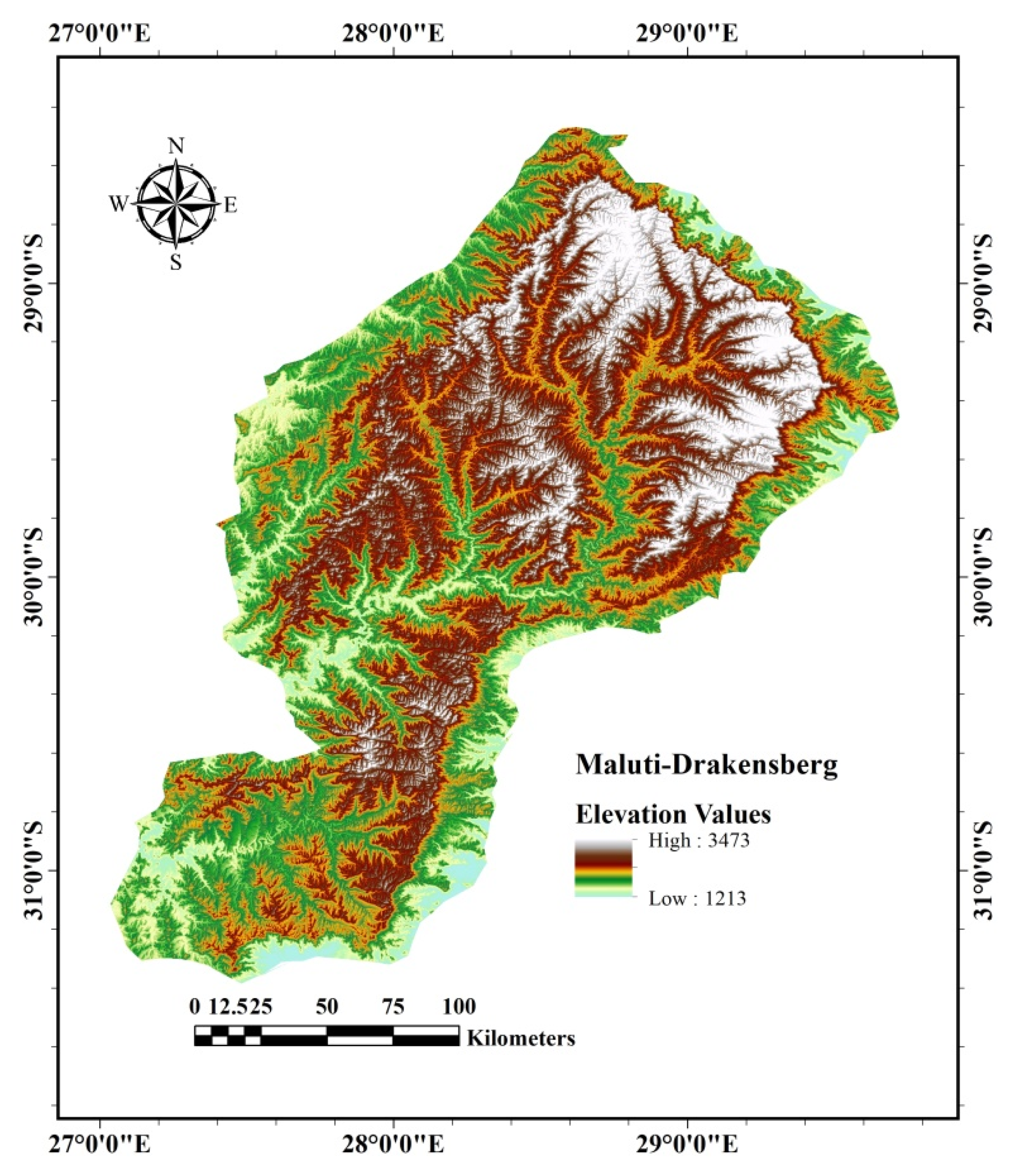
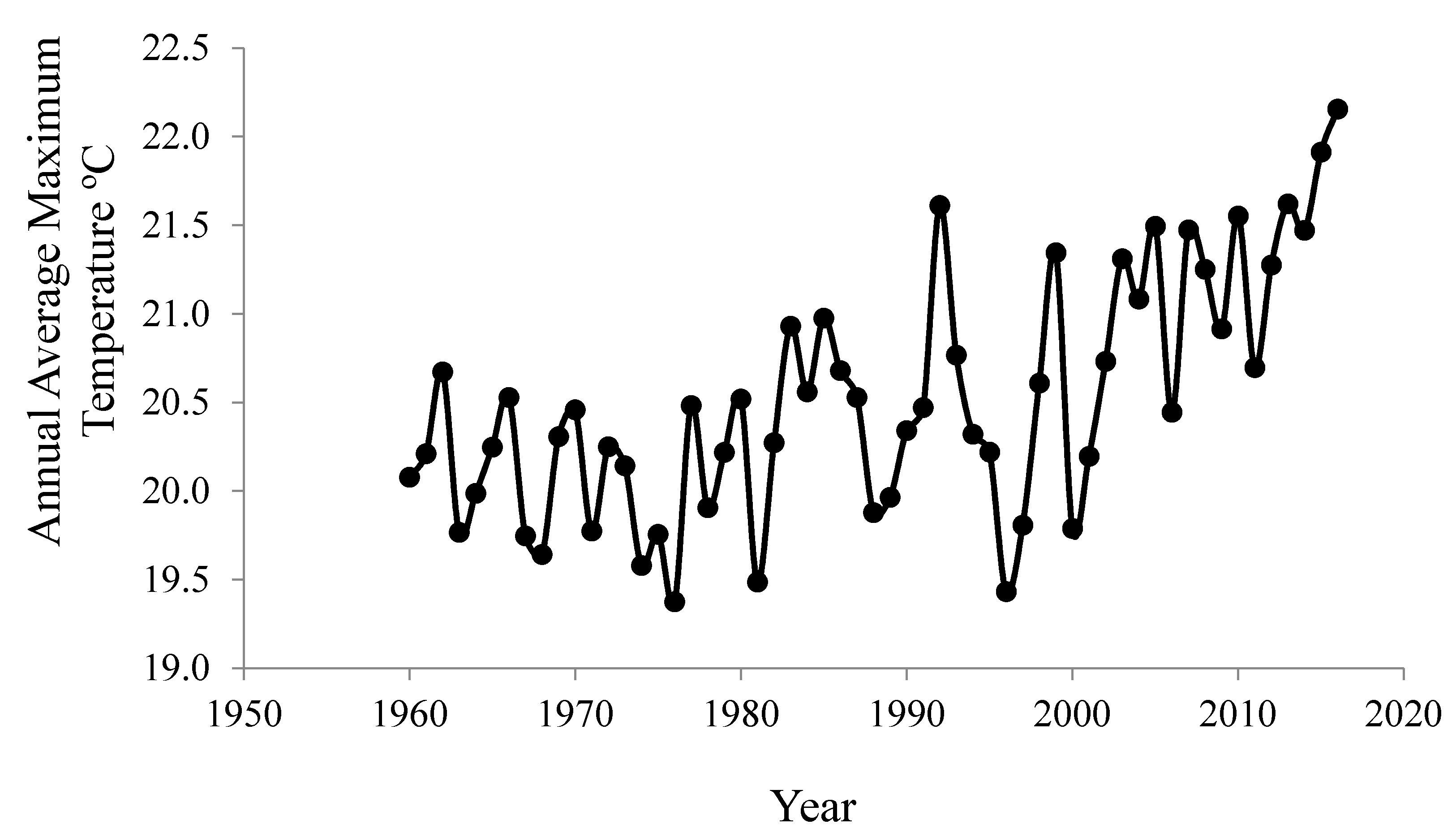

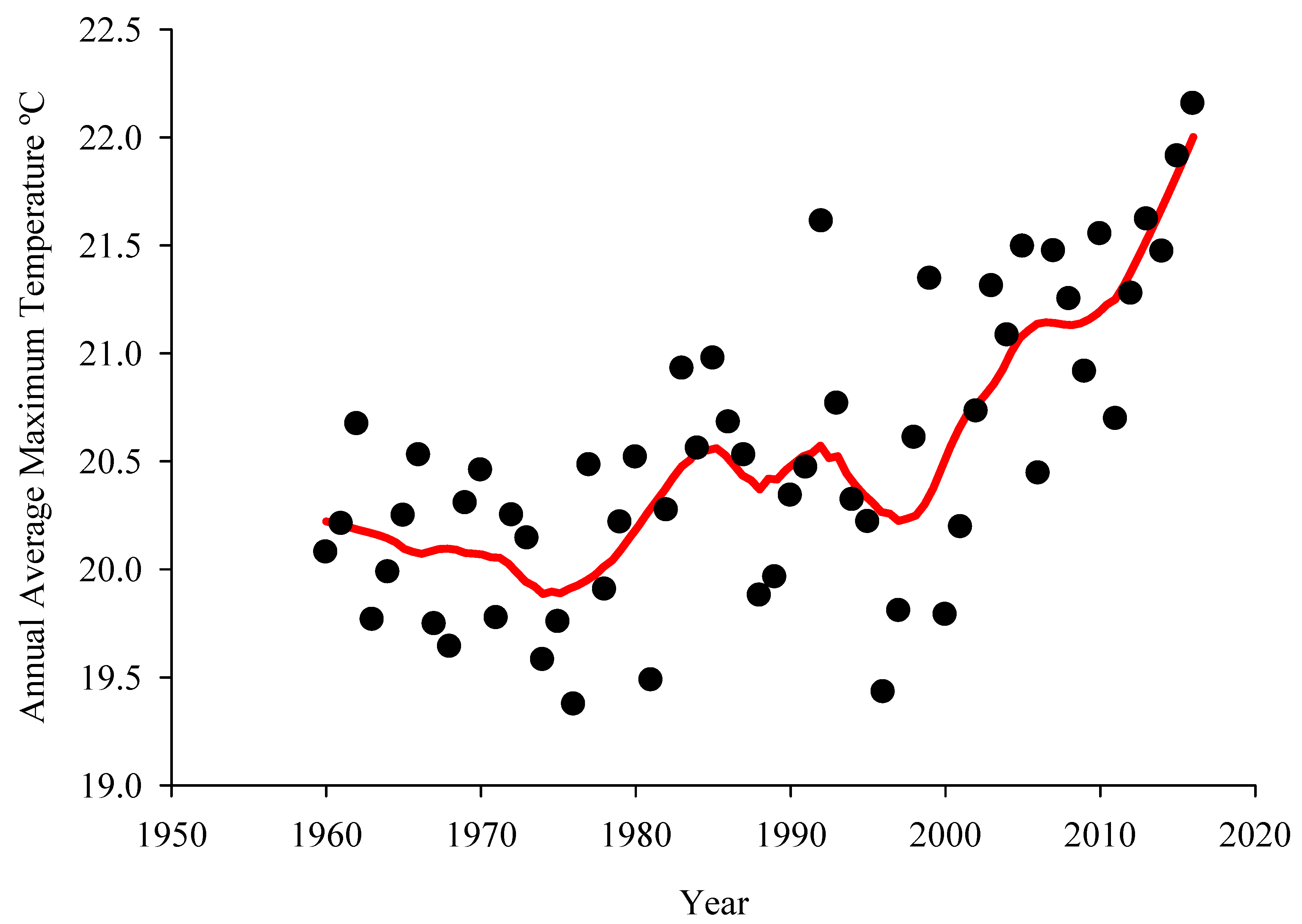


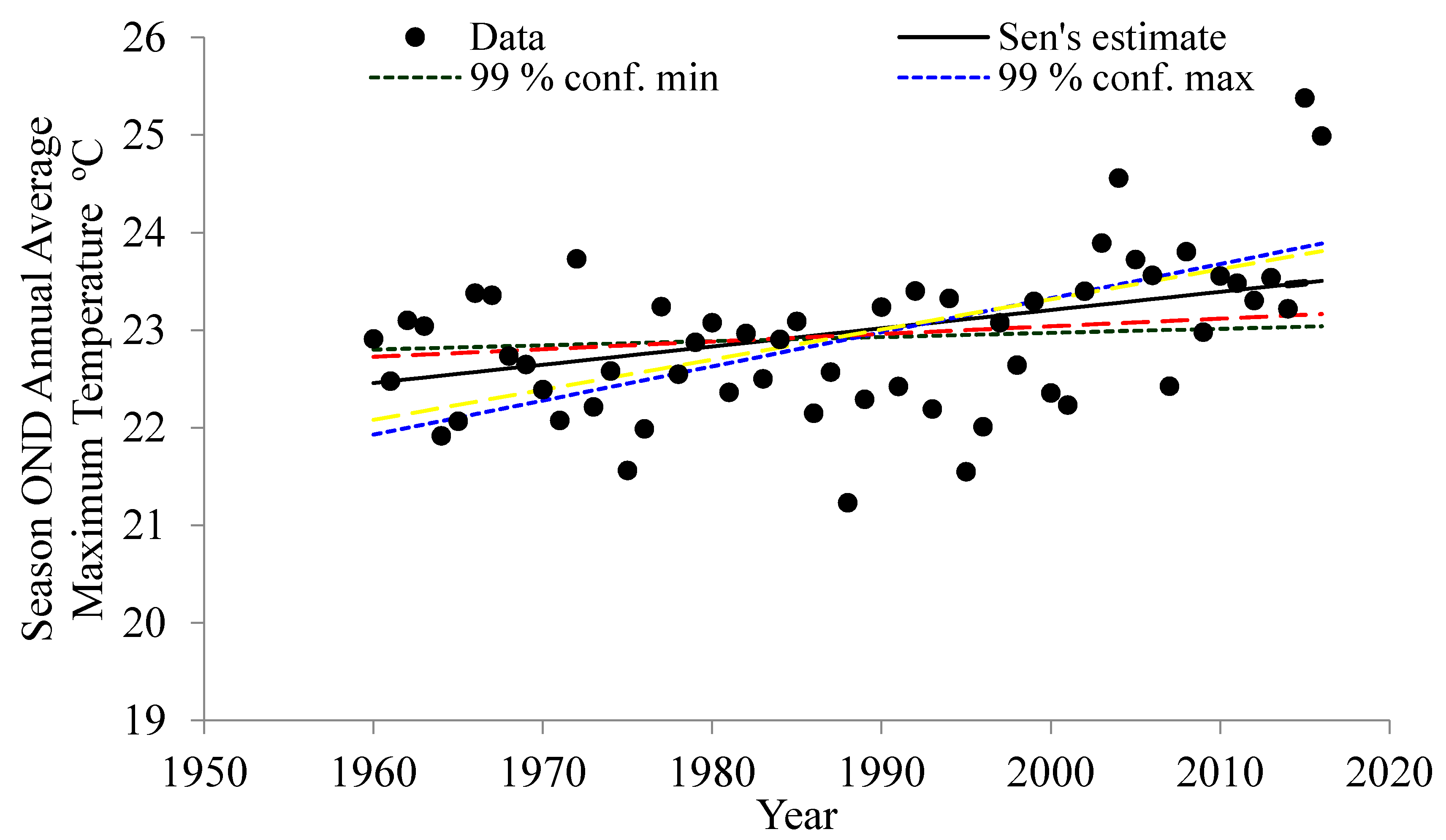
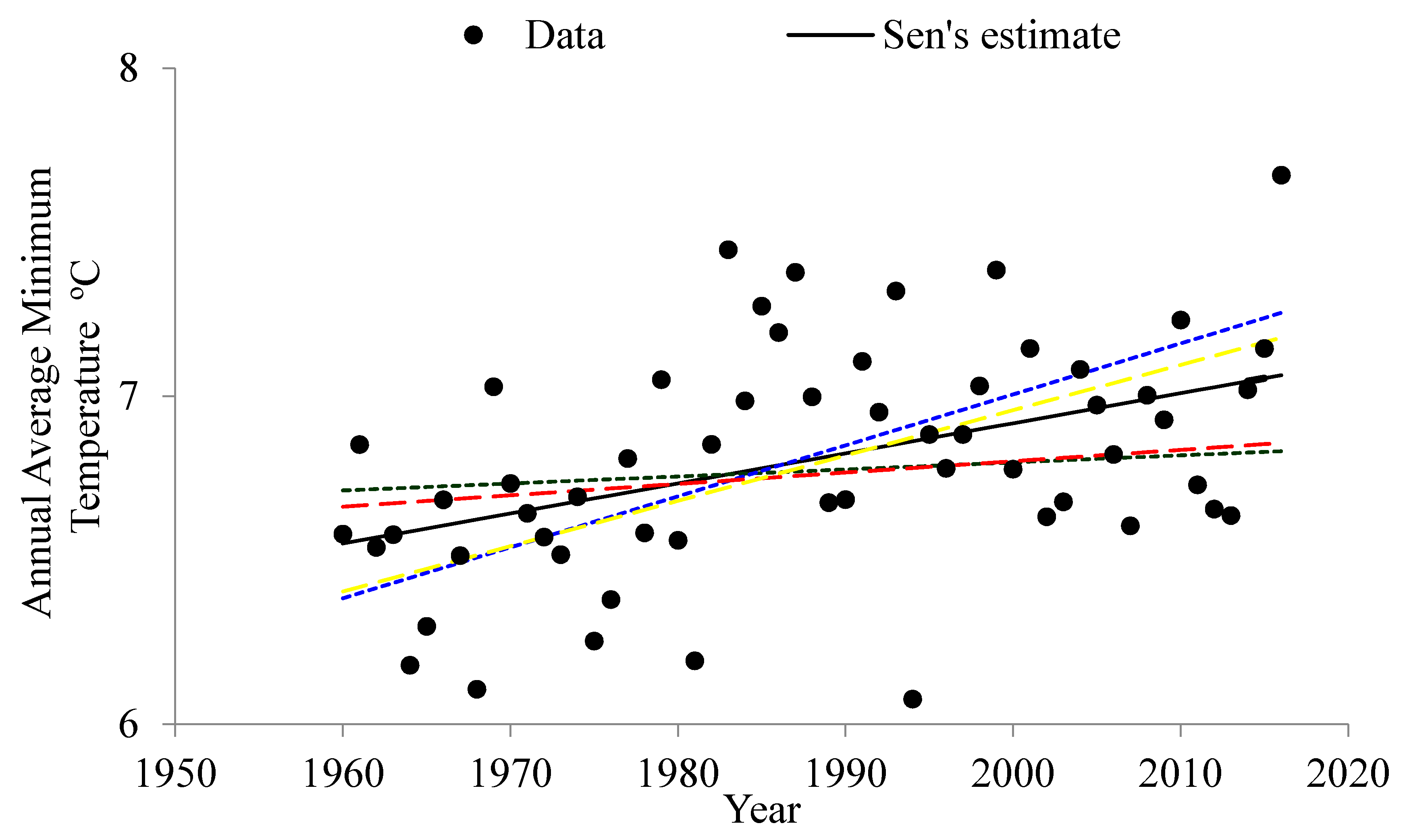
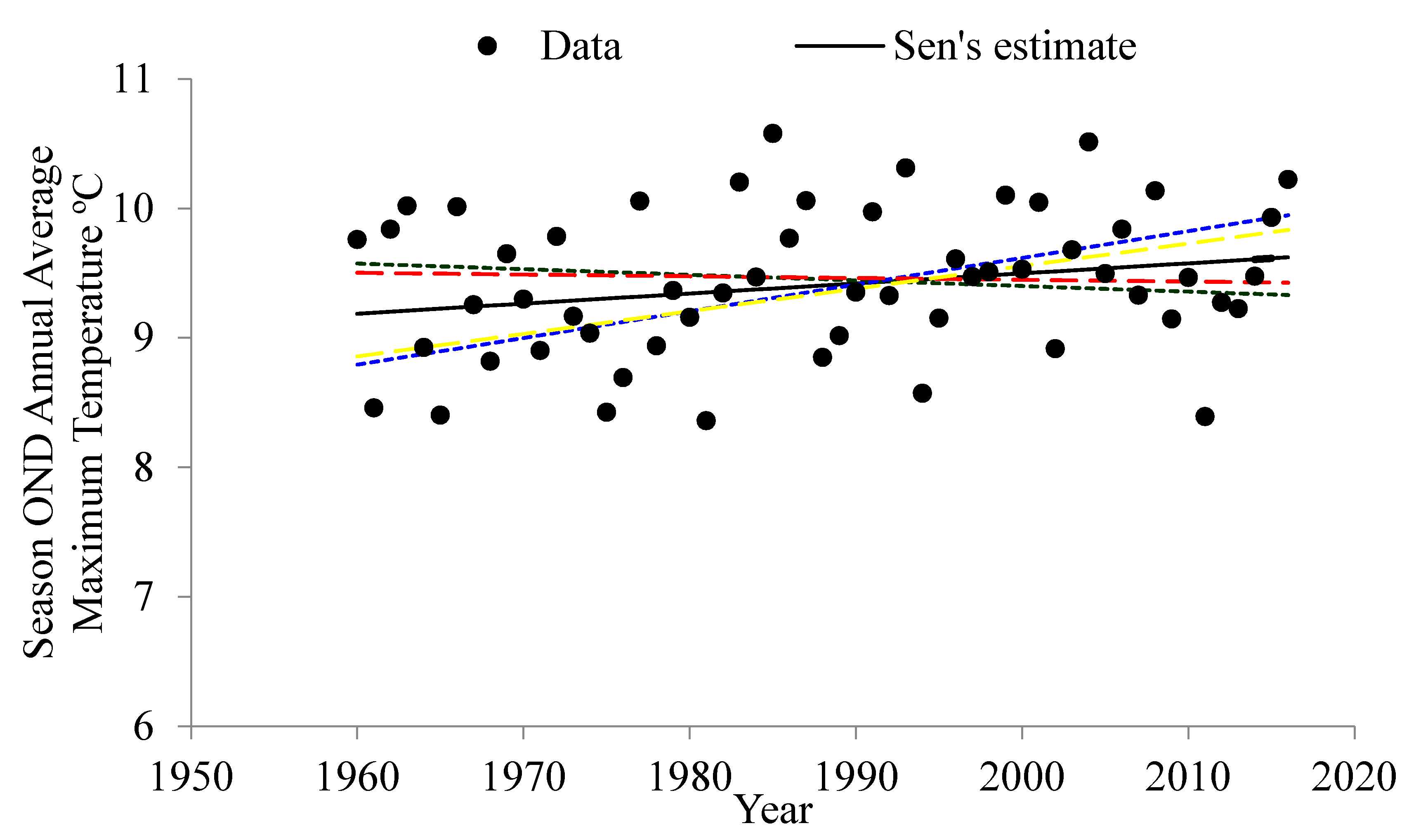
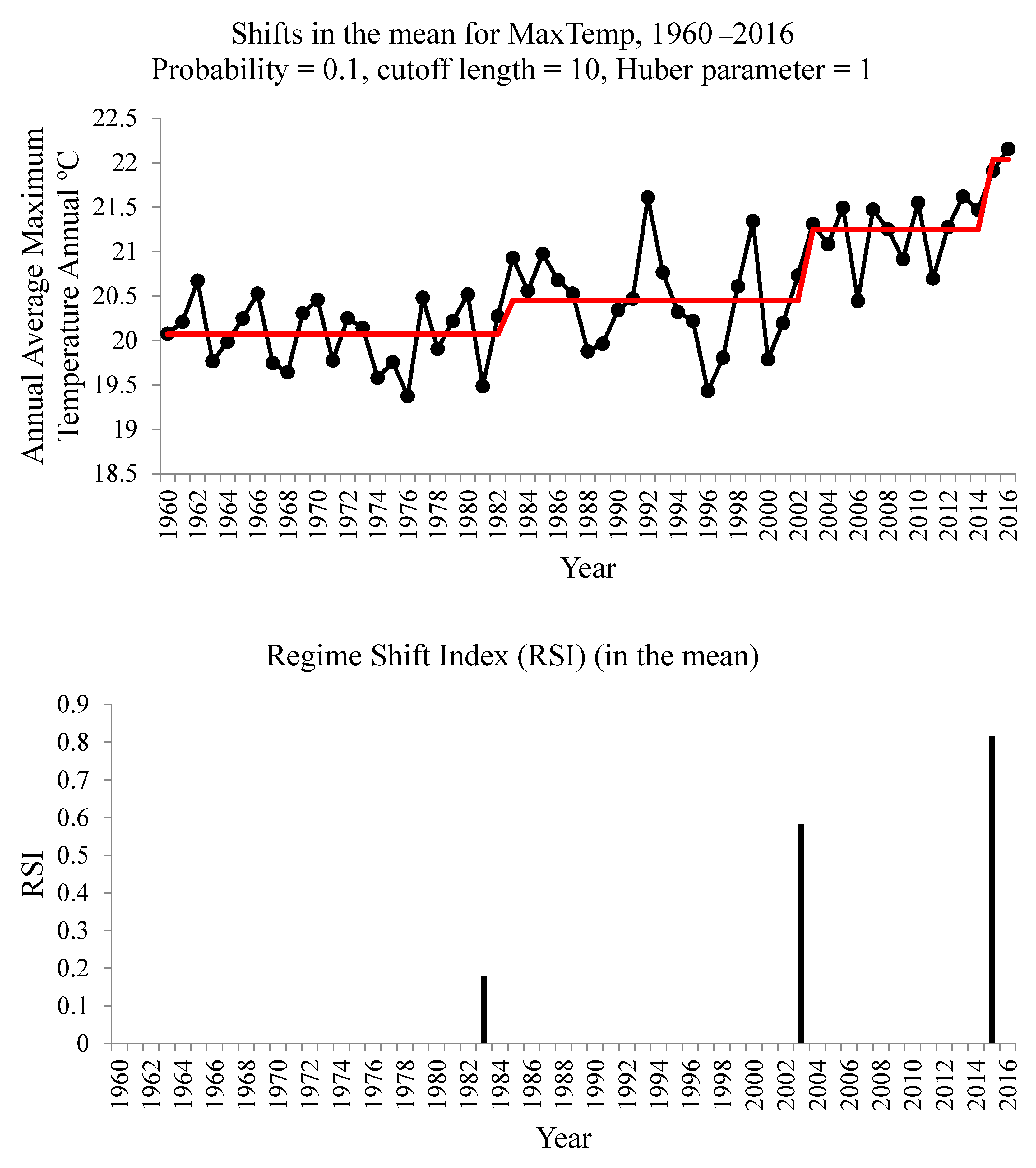
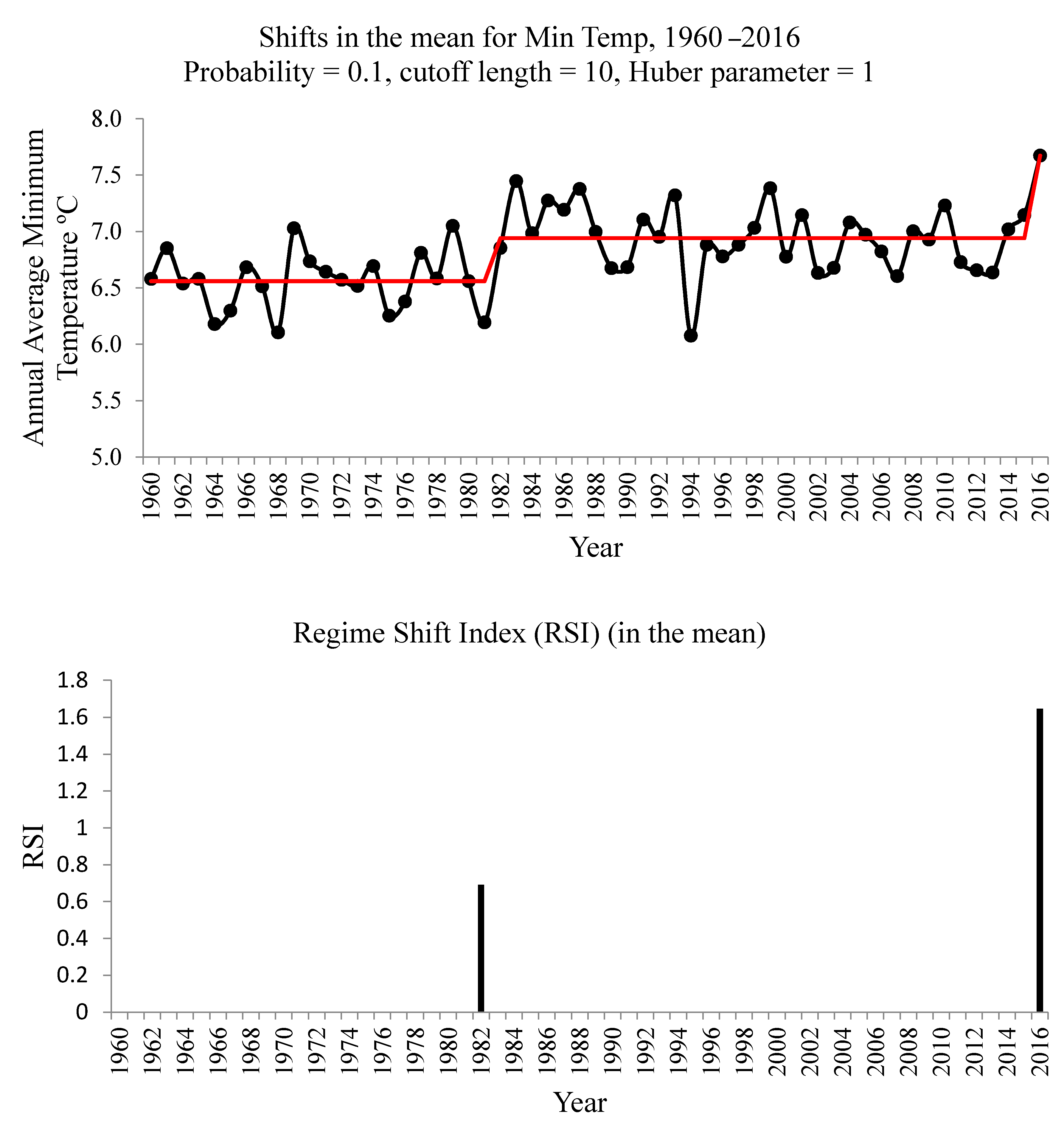
| Statistic Description | Temperature Data |
|---|---|
| Amount of data | 57 |
| Maximum value | 22.15 |
| Minimum value | 19.37 |
| Sum | 1169.18 |
| Mean | 20.51 |
| Std.error | 0.09 |
| Variance | 0.45 |
| Stand. Dev Median Skewness Kurtosis Coeff. Var | 0.67 20.46 0.44 –0.49 3.28% |
| Statistic Description | Temperature Data |
|---|---|
| Amount of data | 57 |
| Maximum value | 7.67 |
| Minimum value | 6.08 |
| Sum | 388 |
| Mean | 6.81 |
| Std.error | 0.05 |
| Variance | 0.12 |
| Stand. Dev Median Skewness Kurtosis Coeff. Var | 0.35 6.78 0.05 –0.08 5.1% |
| Mann–Kendall Trend | Sen’s Slope Estimate | ||||||||||||||
|---|---|---|---|---|---|---|---|---|---|---|---|---|---|---|---|
| Time Series | Start Year | End Year | N | Test Z | Significance | Q | Qmin99 | Qmax99 | Qmin95 | Qmax95 | B | Bmin99 | Bmax99 | Bmin95 | Bmax95 |
| January | 1960 | 2016 | 57 | 2.58 | + | 0.018 | −0.010 | 0.044 | −0.003 | 0.038 | 24.93 | 25.45 | 24.35 | 25.31 | 24.52 |
| February | 1960 | 2016 | 57 | 2.66 | ** | 0.031 | 0.001 | 0.061 | 0.009 | 0.054 | 23.50 | 24.43 | 22.70 | 24.36 | 22.82 |
| March | 1960 | 2016 | 57 | 0.92 | ** | 0.035 | 0.003 | 0.063 | 0.010 | 0.055 | 21.97 | 22.89 | 21.11 | 22.61 | 21.38 |
| April | 1960 | 2016 | 57 | 1.58 | ** | 0.038 | 0.008 | 0.067 | 0.016 | 0.060 | 18.68 | 19.52 | 17.85 | 19.33 | 17.96 |
| May | 1960 | 2016 | 57 | 3.21 | *** | 0.048 | 0.027 | 0.067 | 0.033 | 0.061 | 15.81 | 16.32 | 15.38 | 16.19 | 15.57 |
| June | 1960 | 2016 | 57 | 2.02 | *** | 0.031 | 0.012 | 0.052 | 0.018 | 0.048 | 13.92 | 14.50 | 13.34 | 14.40 | 13.44 |
| July | 1960 | 2016 | 57 | 0.90 | * | 0.017 | −0.003 | 0.041 | 0.003 | 0.035 | 14.64 | 15.24 | 14.16 | 15.04 | 14.33 |
| August | 1960 | 2016 | 57 | 1.08 | * | 0.023 | 0.000 | 0.048 | 0.006 | 0.042 | 16.56 | 17.20 | 15.91 | 17.06 | 15.96 |
| September | 1960 | 2016 | 57 | −0.32 | + | 0.019 | −0.006 | 0.045 | 0.000 | 0.038 | 19.94 | 20.56 | 19.20 | 20.48 | 19.39 |
| October | 1960 | 2016 | 57 | 1.15 | *** | 0.030 | 0.008 | 0.058 | 0.013 | 0.052 | 20.73 | 21.30 | 19.7178 | 21.093 | 19.9275 |
| November | 1960 | 2016 | 57 | −0.12 | ** | 0.022 | 0.000 | 0.042 | 0.005 | 0.037 | 22.156 | 22.6259 | 21.581 | 22.626 | 21.6809 |
| December | 1960 | 2016 | 57 | 1.99 | 0.008 | −0.016 | 0.032 | −0.011 | 0.025 | 24.189 | 24.7835 | 23.6275 | 24.597 | 23.724 | |
| ANNUAL | 1960 | 2016 | 57 | 3.34 | *** | 0.026 | 0.015 | 0.038 | 0.018 | 0.035 | 19.881 | 20.1143 | 19.4974 | 20.032 | 19.5687 |
| OND | 1960 | 2016 | 57 | 1.63 | ** | 0.019 | 0.004 | 0.035 | 0.008 | 0.031 | 22.46 | 22.8045 | 21.9308 | 22.728 | 22.0821 |
| Mann–Kendall Trend | Sen’s Slope Estimate | ||||||||||||||
|---|---|---|---|---|---|---|---|---|---|---|---|---|---|---|---|
| Time Series | Start Year | End Year | N | Test Z | Significance | Q | Qmin99 | Qmax99 | Qmin95 | Qmax95 | B | Bmin99 | Bmax99 | Bmin95 | Bmax95 |
| January | 1960 | 2016 | 57 | 2.58 | ** | 0.014 | 0.000 | 0.028 | 0.004 | 0.025 | 12.10 | 12.55 | 11.83 | 12.44 | 11.87 |
| February | 1960 | 2016 | 57 | 2.66 | ** | 0.018 | 0.001 | 0.033 | 0.005 | 0.030 | 11.66 | 12.08 | 11.31 | 11.99 | 11.37 |
| March | 1960 | 2016 | 57 | 0.92 | 0.007 | −0.011 | 0.024 | −0.006 | 0.021 | 10.45 | 11.12 | 9.88 | 10.95 | 10.00 | |
| April | 1960 | 2016 | 57 | 1.58 | 0.015 | −0.010 | 0.033 | −0.003 | 0.028 | 6.56 | 7.26 | 6.04 | 7.02 | 6.09 | |
| May | 1960 | 2016 | 57 | 3.21 | ** | 0.021 | 0.004 | 0.039 | 0.010 | 0.035 | 2.69 | 3.14 | 2.12 | 3.06 | 2.23 |
| June | 1960 | 2016 | 57 | 2.02 | * | 0.014 | −0.005 | 0.032 | 0.000 | 0.027 | −0.29 | 0.22 | −0.83 | 0.15 | −0.65 |
| July | 1960 | 2016 | 57 | 0.90 | 0.008 | −0.013 | 0.027 | −0.008 | 0.023 | −0.15 | 0.35 | −0.59 | 0.24 | −0.50 | |
| August | 1960 | 2016 | 57 | 1.08 | 0.009 | −0.013 | 0.027 | −0.007 | 0.023 | 1.94 | 2.50 | 1.24 | 2.36 | 1.40 | |
| September | 1960 | 2016 | 57 | −0.32 | −0.003 | −0.023 | 0.017 | −0.018 | 0.011 | 5.53 | 6.09 | 4.91 | 5.93 | 5.16 | |
| October | 1960 | 2016 | 57 | 1.15 | 0.009 | −0.011 | 0.030 | −0.006 | 0.024 | 7.59 | 8.13 | 6.89293 | 7.9534 | 7.05845 | |
| November | 1960 | 2016 | 57 | −0.12 | −0.001 | −0.017 | 0.015 | −0.014 | 0.011 | 9.4359 | 9.86805 | 9.01978 | 9.7777 | 9.10037 | |
| December | 1960 | 2016 | 57 | 1.99 | * | 0.010 | −0.003 | 0.024 | 0.000 | 0.021 | 10.833 | 11.232 | 10.4194 | 11.125 | 10.4911 |
| ANNUAL | 1960 | 2016 | 57 | 3.34 | *** | 0.009 | 0.002 | 0.016 | 0.003 | 0.014 | 6.5524 | 6.7152 | 6.3862 | 6.6624 | 6.40689 |
| OND | 1960 | 2016 | 57 | 1.63 | 0.008 | −0.004 | 0.021 | −0.001 | 0.017 | 9.192 | 9.5759 | 8.79038 | 9.5068 | 8.85775 | |
© 2019 by the authors. Licensee MDPI, Basel, Switzerland. This article is an open access article distributed under the terms and conditions of the Creative Commons Attribution (CC BY) license (http://creativecommons.org/licenses/by/4.0/).
Share and Cite
Mohamed, A.A.; Mukwada, G. Temperature Changes in the Maloti-Drakensberg Region: An Analysis of Trends for the 1960–2016 Period. Atmosphere 2019, 10, 471. https://doi.org/10.3390/atmos10080471
Mohamed AA, Mukwada G. Temperature Changes in the Maloti-Drakensberg Region: An Analysis of Trends for the 1960–2016 Period. Atmosphere. 2019; 10(8):471. https://doi.org/10.3390/atmos10080471
Chicago/Turabian StyleMohamed, Abdelmoneim Abdelsalam, and Geoffrey Mukwada. 2019. "Temperature Changes in the Maloti-Drakensberg Region: An Analysis of Trends for the 1960–2016 Period" Atmosphere 10, no. 8: 471. https://doi.org/10.3390/atmos10080471




